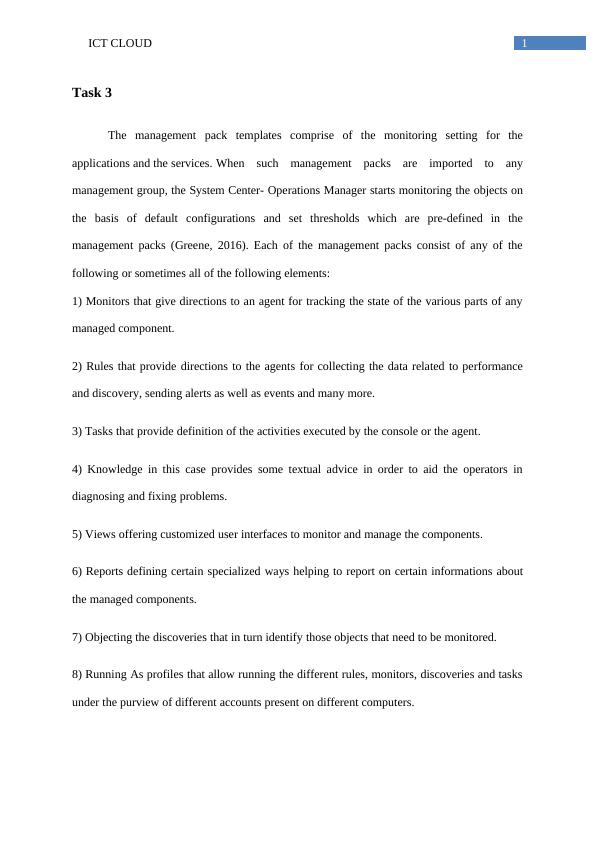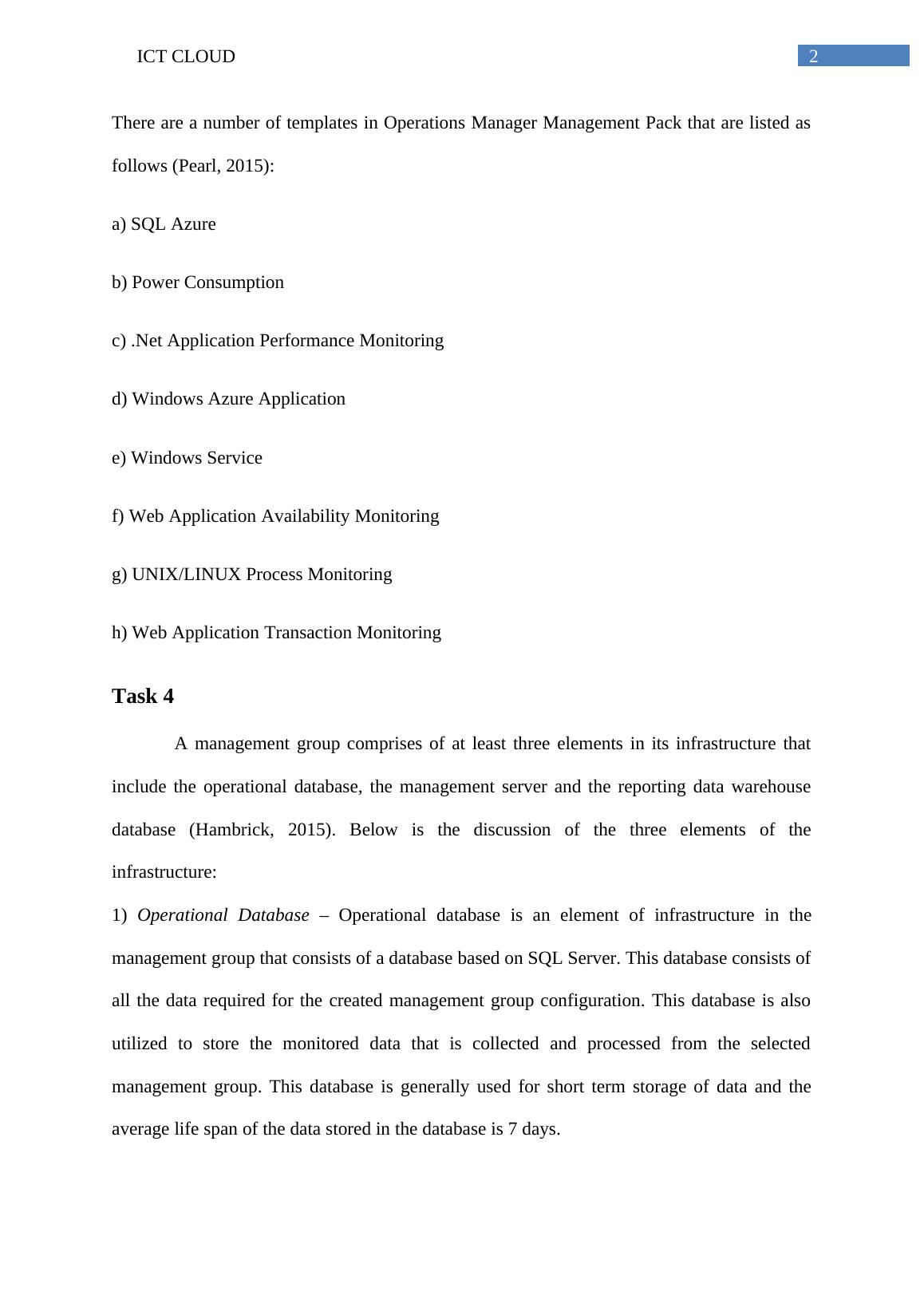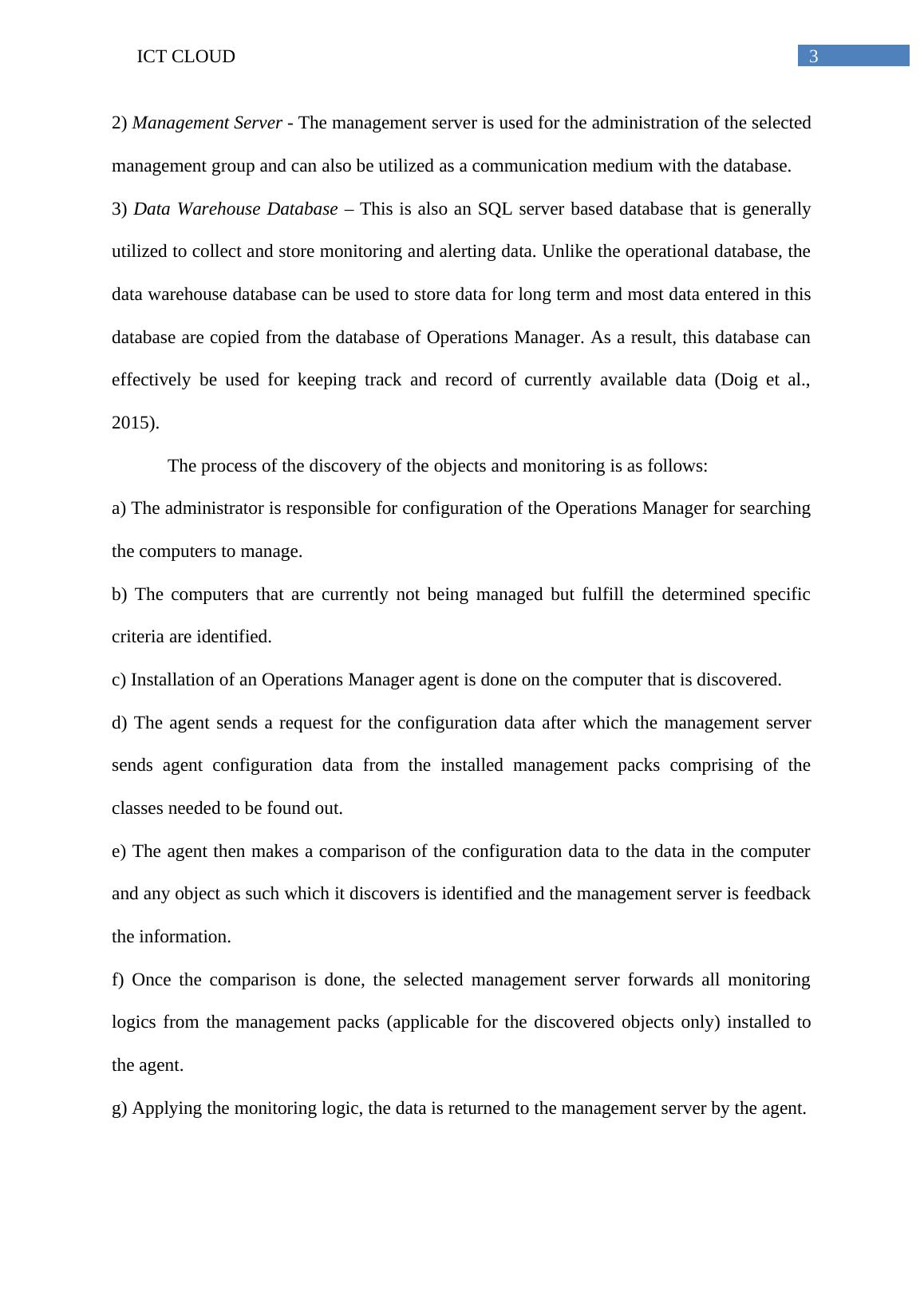Management Pack Templates and Infrastructure of a Management Group
Added on 2022-11-13
12 Pages3249 Words312 Views
Running head: ICT CLOUD
ICT CLOUD
Name of the Student
Name of the university
Author note
ICT CLOUD
Name of the Student
Name of the university
Author note

1ICT CLOUD
Task 3
The management pack templates comprise of the monitoring setting for the
applications and the services. When such management packs are imported to any
management group, the System Center- Operations Manager starts monitoring the objects on
the basis of default configurations and set thresholds which are pre-defined in the
management packs (Greene, 2016). Each of the management packs consist of any of the
following or sometimes all of the following elements:
1) Monitors that give directions to an agent for tracking the state of the various parts of any
managed component.
2) Rules that provide directions to the agents for collecting the data related to performance
and discovery, sending alerts as well as events and many more.
3) Tasks that provide definition of the activities executed by the console or the agent.
4) Knowledge in this case provides some textual advice in order to aid the operators in
diagnosing and fixing problems.
5) Views offering customized user interfaces to monitor and manage the components.
6) Reports defining certain specialized ways helping to report on certain informations about
the managed components.
7) Objecting the discoveries that in turn identify those objects that need to be monitored.
8) Running As profiles that allow running the different rules, monitors, discoveries and tasks
under the purview of different accounts present on different computers.
Task 3
The management pack templates comprise of the monitoring setting for the
applications and the services. When such management packs are imported to any
management group, the System Center- Operations Manager starts monitoring the objects on
the basis of default configurations and set thresholds which are pre-defined in the
management packs (Greene, 2016). Each of the management packs consist of any of the
following or sometimes all of the following elements:
1) Monitors that give directions to an agent for tracking the state of the various parts of any
managed component.
2) Rules that provide directions to the agents for collecting the data related to performance
and discovery, sending alerts as well as events and many more.
3) Tasks that provide definition of the activities executed by the console or the agent.
4) Knowledge in this case provides some textual advice in order to aid the operators in
diagnosing and fixing problems.
5) Views offering customized user interfaces to monitor and manage the components.
6) Reports defining certain specialized ways helping to report on certain informations about
the managed components.
7) Objecting the discoveries that in turn identify those objects that need to be monitored.
8) Running As profiles that allow running the different rules, monitors, discoveries and tasks
under the purview of different accounts present on different computers.

2ICT CLOUD
There are a number of templates in Operations Manager Management Pack that are listed as
follows (Pearl, 2015):
a) SQL Azure
b) Power Consumption
c) .Net Application Performance Monitoring
d) Windows Azure Application
e) Windows Service
f) Web Application Availability Monitoring
g) UNIX/LINUX Process Monitoring
h) Web Application Transaction Monitoring
Task 4
A management group comprises of at least three elements in its infrastructure that
include the operational database, the management server and the reporting data warehouse
database (Hambrick, 2015). Below is the discussion of the three elements of the
infrastructure:
1) Operational Database – Operational database is an element of infrastructure in the
management group that consists of a database based on SQL Server. This database consists of
all the data required for the created management group configuration. This database is also
utilized to store the monitored data that is collected and processed from the selected
management group. This database is generally used for short term storage of data and the
average life span of the data stored in the database is 7 days.
There are a number of templates in Operations Manager Management Pack that are listed as
follows (Pearl, 2015):
a) SQL Azure
b) Power Consumption
c) .Net Application Performance Monitoring
d) Windows Azure Application
e) Windows Service
f) Web Application Availability Monitoring
g) UNIX/LINUX Process Monitoring
h) Web Application Transaction Monitoring
Task 4
A management group comprises of at least three elements in its infrastructure that
include the operational database, the management server and the reporting data warehouse
database (Hambrick, 2015). Below is the discussion of the three elements of the
infrastructure:
1) Operational Database – Operational database is an element of infrastructure in the
management group that consists of a database based on SQL Server. This database consists of
all the data required for the created management group configuration. This database is also
utilized to store the monitored data that is collected and processed from the selected
management group. This database is generally used for short term storage of data and the
average life span of the data stored in the database is 7 days.

3ICT CLOUD
2) Management Server - The management server is used for the administration of the selected
management group and can also be utilized as a communication medium with the database.
3) Data Warehouse Database – This is also an SQL server based database that is generally
utilized to collect and store monitoring and alerting data. Unlike the operational database, the
data warehouse database can be used to store data for long term and most data entered in this
database are copied from the database of Operations Manager. As a result, this database can
effectively be used for keeping track and record of currently available data (Doig et al.,
2015).
The process of the discovery of the objects and monitoring is as follows:
a) The administrator is responsible for configuration of the Operations Manager for searching
the computers to manage.
b) The computers that are currently not being managed but fulfill the determined specific
criteria are identified.
c) Installation of an Operations Manager agent is done on the computer that is discovered.
d) The agent sends a request for the configuration data after which the management server
sends agent configuration data from the installed management packs comprising of the
classes needed to be found out.
e) The agent then makes a comparison of the configuration data to the data in the computer
and any object as such which it discovers is identified and the management server is feedback
the information.
f) Once the comparison is done, the selected management server forwards all monitoring
logics from the management packs (applicable for the discovered objects only) installed to
the agent.
g) Applying the monitoring logic, the data is returned to the management server by the agent.
2) Management Server - The management server is used for the administration of the selected
management group and can also be utilized as a communication medium with the database.
3) Data Warehouse Database – This is also an SQL server based database that is generally
utilized to collect and store monitoring and alerting data. Unlike the operational database, the
data warehouse database can be used to store data for long term and most data entered in this
database are copied from the database of Operations Manager. As a result, this database can
effectively be used for keeping track and record of currently available data (Doig et al.,
2015).
The process of the discovery of the objects and monitoring is as follows:
a) The administrator is responsible for configuration of the Operations Manager for searching
the computers to manage.
b) The computers that are currently not being managed but fulfill the determined specific
criteria are identified.
c) Installation of an Operations Manager agent is done on the computer that is discovered.
d) The agent sends a request for the configuration data after which the management server
sends agent configuration data from the installed management packs comprising of the
classes needed to be found out.
e) The agent then makes a comparison of the configuration data to the data in the computer
and any object as such which it discovers is identified and the management server is feedback
the information.
f) Once the comparison is done, the selected management server forwards all monitoring
logics from the management packs (applicable for the discovered objects only) installed to
the agent.
g) Applying the monitoring logic, the data is returned to the management server by the agent.

End of preview
Want to access all the pages? Upload your documents or become a member.
Related Documents
SCOM (Systems Centre Operations Manager)lg...
|7
|1335
|130
Configuration and Deployment of Cloud infrastructure Assignmentlg...
|11
|2618
|122
Deploying and Configuration of Cloud infrastructure PDFlg...
|23
|4690
|32
NETWORKING AND SCOM Networking and Operations Manager SCOM Namelg...
|26
|3845
|192
Configuration and Deployment of Cloud Infrastructurelg...
|25
|7236
|393
Microsoft developed a growing set of Microsoft Azure Cloudlg...
|2
|410
|19
